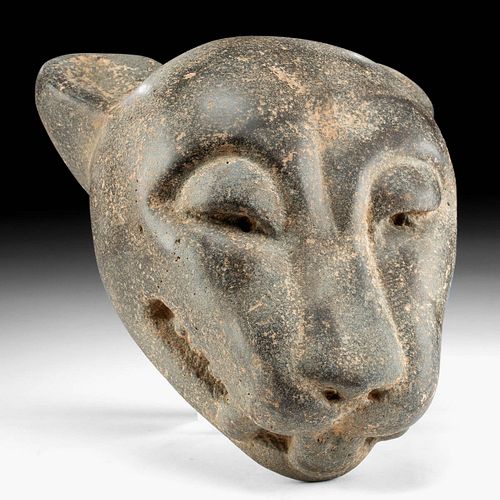Choice / Large Aztec Stone Jaguar Head
Lot 221
About Seller
Artemis Fine Arts
686 S Taylor Ave, Ste 106
Louisville, CO 80027
United States
Selling antiquities, ancient and ethnographic art online since 1993, Artemis Gallery specializes in Classical Antiquities (Egyptian, Greek, Roman, Near Eastern), Asian, Pre-Columbian, African / Tribal / Oceanographic art. Our extensive inventory includes pottery, stone, metal, wood, glass and textil...Read more
Estimate:
$6,000 - $9,000
Absentee vs Live bid
Two ways to bid:
- Leave a max absentee bid and the platform will bid on your behalf up to your maximum bid during the live auction.
- Bid live during the auction and your bids will be submitted real-time to the auctioneer.
Bid Increments
| Price | Bid Increment |
|---|---|
| $0 | $25 |
| $300 | $50 |
| $1,000 | $100 |
| $2,000 | $250 |
| $5,000 | $500 |
| $10,000 | $1,000 |
| $20,000 | $2,500 |
| $50,000 | $5,000 |
| $100,000 | $10,000 |
| $200,000 | $20,000 |
About Auction
By Artemis Fine Arts
Oct 7, 2021
Set Reminder
2021-10-07 10:00:00
2021-10-07 10:00:00
America/New_York
Bidsquare
Bidsquare : Exceptional Antiquities Ethnographic Fine Art
https://www.bidsquare.com/auctions/artemis-gallery/exceptional-antiquities-ethnographic-fine-art-7537
Museum-worthy examples of Egyptian, Greek, Roman, Etruscan, Near Eastern, Far East / Asian, Pre-Columbian, African / Tribal, Oceanic, Native American, Spanish Colonial, Fossils, Ancient Jewelry, Fine / Visual Arts, so much more! Artemis Fine Arts info@artemisfinearts.com
Museum-worthy examples of Egyptian, Greek, Roman, Etruscan, Near Eastern, Far East / Asian, Pre-Columbian, African / Tribal, Oceanic, Native American, Spanish Colonial, Fossils, Ancient Jewelry, Fine / Visual Arts, so much more! Artemis Fine Arts info@artemisfinearts.com
- Lot Description
Pre-Columbian, Mexico, Mexico City region, Aztec Empire, ca. 1300 to 1500 CE. This is one of the best jaguar sculptures we have seen, and an amazing naturalistic rendering of this feline head from a hefty stone. The polished surface is delightfully tactile and silky from hours of painstaking pecking. The features are realistically rendered, with the lip pulled back to show a protruding tongue, large fangs, and rows of teeth. The narrow muzzle has shallow drilled nostrils, and the snout leads up to the slightly furrowed brow, and the head curves back, surmounted by perked ears. The heavily lidded eyes have drilled pupils, perhaps for inlaying colorful, stones or shells to enliven to this stone creature. Jaguar imagery symbolized power and might throughout the Pre-Columbian world; warriors, rulers, and shamans alike associated themselves with the largest and most powerful feline in the New World. This rendering is beautiful, and undoubtably graced a temple or place of importance. Size: 6.5" L x 3.75" W x 8.5" H (16.5 cm x 9.5 cm x 21.6 cm)
The jaguar - "ocelotl" in Nahautl - was associated with military and social power, war, night, black magic, and the god of darkness, Tezcatlipoca - known as "Smoking Mirror" - who sometimes appeared in jaguar form. Rulers are often depicted dressed in jaguar skins or sitting on them. One of the two classes of elite soldiers in Aztec society were the jaguar warriors, who were believed to embody the ferocity of the animal itself - in order to become a jaguar warrior, they had to capture four enemies in battle who would later be sacrificed. This statue may have graced a military academy where jaguar warriors trained.
The Spaniards wrote that the Aztecs believed that stone meant to be carved had magical properties and was alive, able to speak and prophecy. While today we classify rocks scientifically, i.e. igneous, sedimentary, etc., the Aztecs had a very different method for classifying them. Different rocks that they used in lapidary work (and shell, which they also considered a form of rock) were classified according to properties like brightness, density, healing power, and magical ability. Aztec stone sculpture is a culmination of centuries of lapidary practice in Mesoamerica, and they were able to create remarkably naturalistic and detailed artworks, as exemplified by this piece!
For a similar example, please see the Philadelphia Museum of website, accession number: 1950-134-333.
This piece has been searched against the Art Loss Register database and has been cleared. The Art Loss Register maintains the world's largest database of stolen art, collectibles, and antiques.
Provenance: private Elkton, Oregon, USA collection, acquired prior to 2000
All items legal to buy/sell under U.S. Statute covering cultural patrimony Code 2600, CHAPTER 14, and are guaranteed to be as described or your money back.
A Certificate of Authenticity will accompany all winning bids.
PLEASE NOTE: Due to recent increases of shipments being seized by Australian & German customs (even for items with pre-UNESCO provenance), we will no longer ship most antiquities and ancient Chinese art to Australia & Germany. For categories of items that are acceptable to ship to Australia or Germany, please contact us directly or work with your local customs brokerage firm.
Display stands not described as included/custom in the item description are for photography purposes only and will not be included with the item upon shipping.
#167938Intact and choice. Surface abrasions, chips, and pitting. Scattered mineral deposits. Felt pads added to the base for stability. Silky smooth surface.Condition
- Shipping Info
-
All shipping is handled in-house for your convenience. Your invoice from Artemis Gallery will include shipping calculation instructions. If in doubt, please inquire BEFORE bidding for estimated shipping costs for individual items.
-
- Buyer's Premium



 EUR
EUR CAD
CAD AUD
AUD GBP
GBP MXN
MXN HKD
HKD CNY
CNY MYR
MYR SEK
SEK SGD
SGD CHF
CHF THB
THB















